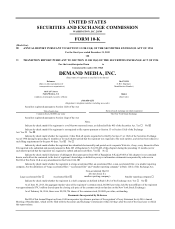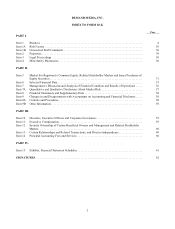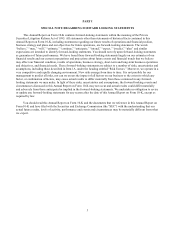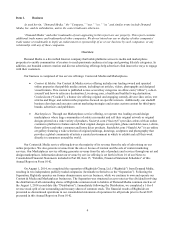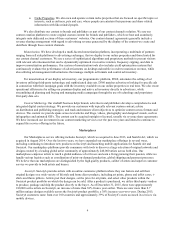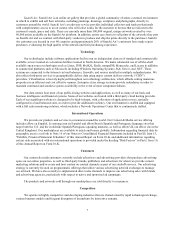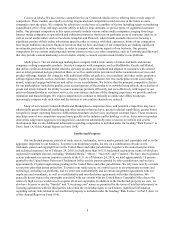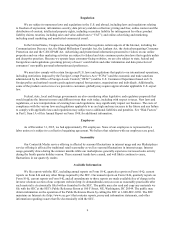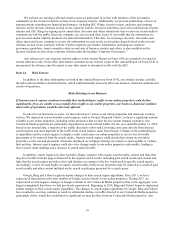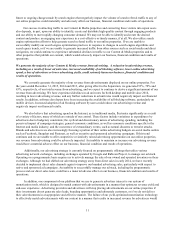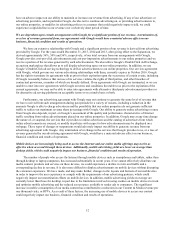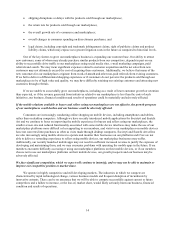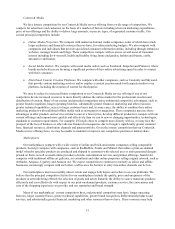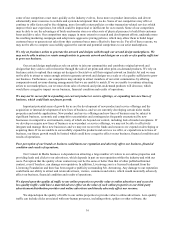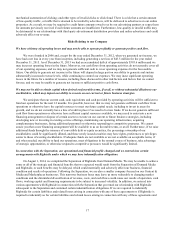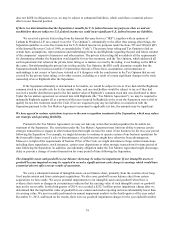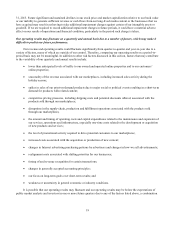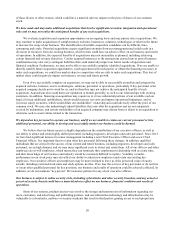Enom 2015 Annual Report Download - page 13
Download and view the complete annual report
Please find page 13 of the 2015 Enom annual report below. You can navigate through the pages in the report by either clicking on the pages listed below, or by using the keyword search tool below to find specific information within the annual report.11
future or ongoing changes made by search engines that negatively impact the volume of search referral traffic to any of
our online properties could materially and adversely affect our business, financial condition and results of operations.
Our success in attracting traffic to our Content & Media properties and converting these visitors into repeat users
also depends, in part, upon our ability to identify, create and distribute high-quality content through engaging products
and our ability to meet rapidly changing consumer demand. We may not be able to identify and create the desired
content and produce an engaging user experience in a cost-effective or timely manner, if at all. We also utilize search
engine optimization efforts to help generate search referral traffic to our online properties. If we are unable to
successfully modify our search engine optimization practices in response to changes in search engine algorithms and
search query trends, or if we are unable to generate increased traffic from other sources such as social media and direct
navigation, we could continue to experience substantial declines in traffic to our Content & Media properties and to
other properties that publish our content, which would adversely impact our business, financial condition and results of
operations.
We generate the majority of our Content & Media revenue from advertising. A reduction in advertising revenue,
including as a result of lower ad unit rates, increased availability of ad blocking software, lower online advertising
spend, a loss of advertisers or lower advertising yields, could seriously harm our business, financial condition and
results of operations.
We currently generate the majority of our revenue from advertisements displayed on our online properties. For
the years ended December 31, 2015, 2014 and 2013, after giving effect to the Separation, we generated 53%, 70% and
83%, respectively, of our total revenue from advertising, and we expect to continue to derive a significant amount of our
revenue from advertising. We have experienced declines in ad unit rates for both desktop and mobile since 2014,
resulting in lower advertising revenue, and any further reductions in ad unit rates would negatively impact our financial
results. In addition, software developers have been increasing the availability of ad blocking software, particularly on
mobile devices. Increased adoption of ad blocking software by users could reduce our advertising revenue and
negatively impact our financial results.
We also believe that advertising spend on the Internet, as in traditional media, fluctuates significantly as a result
of a variety of factors, many of which are outside of our control. These factors include variations in expenditures by
advertisers due to budgetary constraints; the cyclical and discretionary nature of advertising spending, including the
perceived impact of campaign strategies; general economic conditions, as well as economic conditions specific to the
Internet and media industry; and the occurrence of extraordinary events, such as natural disasters or terrorist attacks.
Brands and advertisers are also increasingly focusing a portion of their online advertising budgets on social media outlets
such as Facebook, Snapchat and Pinterest, as well as on native and sponsored advertising campaigns. If this trend
continues and we are unable to offer competitive or similarly valued advertising opportunities on our online properties,
our revenue from advertising could be adversely impacted. An inability to maintain or increase our advertising revenue
would have a material adverse effect on our business, financial condition and results of operations.
Additionally, our advertising strategy is currently focused on programmatic offerings that utilize various
advertising network exchanges, including exchanges operated by Google and Rubicon Project, to manage our ad stack.
Operating on a programmatic basis requires us to actively manage the sale of our owned and operated inventory on these
exchanges. Although we had shifted our advertising strategy away from direct sales in early 2014, we have recently
decided to implement direct sales channels again to improve our branded advertising sales, particularly with respect to
native and sponsored ad campaigns. An inability to successfully manage our ad stack, including the programmatic
process and our direct sales team, could have a material adverse effect on our business, financial condition and results of
operations.
In addition, one component of our platform that we use to generate advertiser interest is our system of
monetization tools, which is designed to match content with advertisements in a manner that optimizes revenue yield and
end-user experience. Advertising providers and advertisers will stop placing advertisements on our online properties if
their investments do not generate sales leads, branding opportunities and ultimately customers, or if we do not deliver
their advertisements in an appropriate and effective manner. The failure of our yield-optimized monetization technology
to effectively match advertisements with our content in a manner that results in increased revenue for advertisers would


